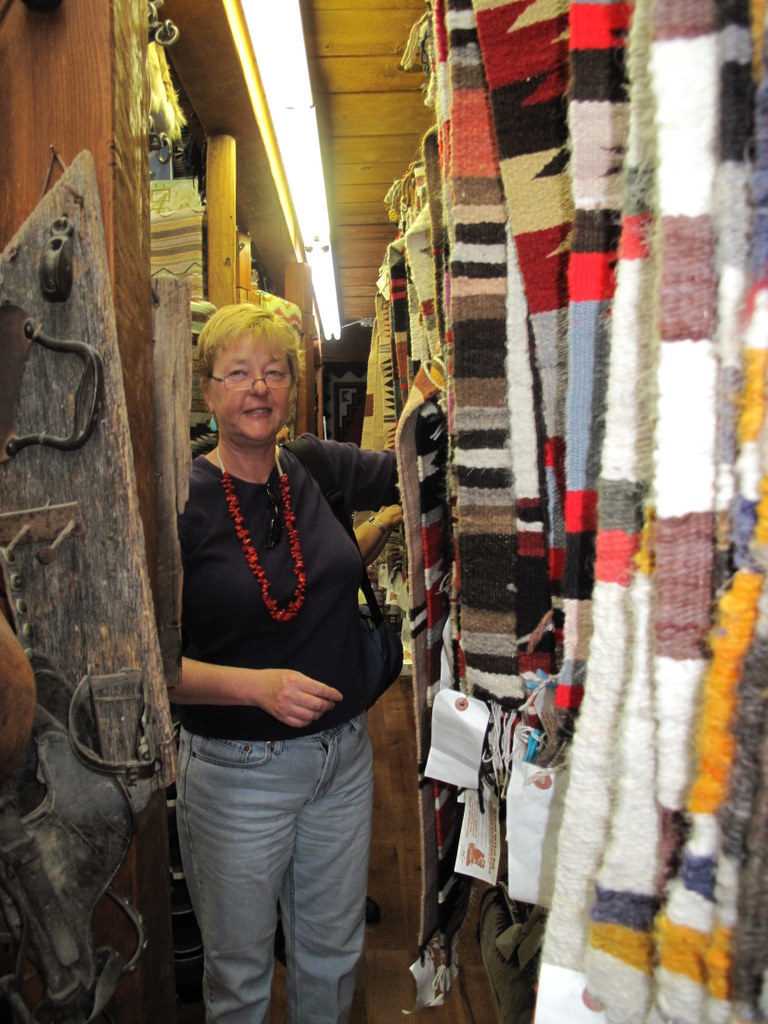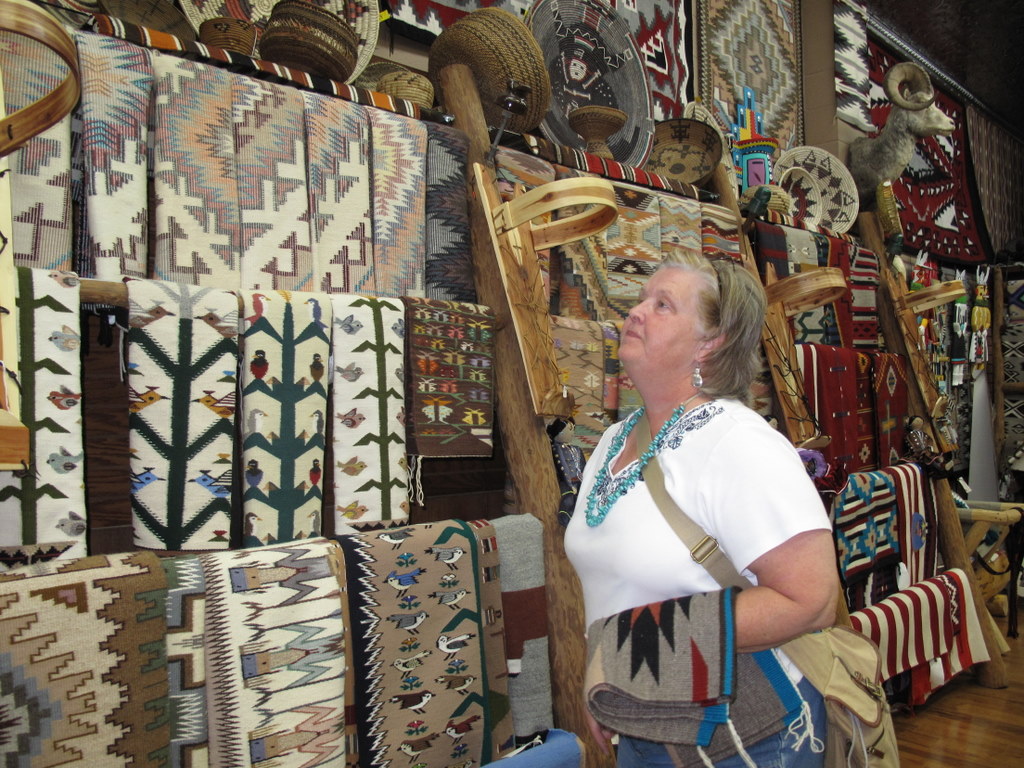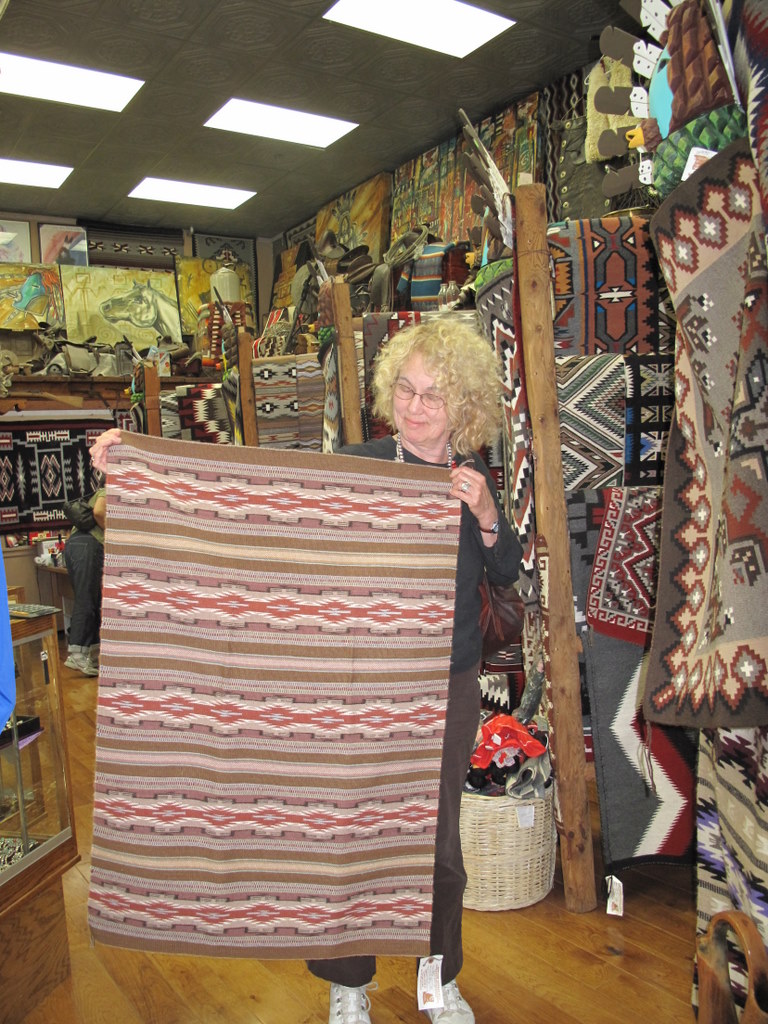About Ten Days Ago in Gallup
Tempe, AZ We’re all home now, so I’ll catch you up on some pictures that I took of our students during our latest class. Although I do an entry on our general activities during the class, I wait until after the session is over to post pictures of the students.
Day one of the class is dedicated to getting the warps done. The better the warp is, the more fun you’ll have with your weaving. We do our warps in teams so that everyone gets to do two warps. It helps us bond as a class and going through the process twice helps to fix it in the students’ minds. It takes most of the morning to do, especially since I had to bring all of the looms and equipment out of storage that morning since I’d gotten to Window Rock just as the access to my storage unit was locked the before. The group was great about helping out and we had everything set up in short order.

Pam Ober checks out the Gallup throws. These are special type of Navajo weaving for the tourist trade.
Our field trip for the day was a trip into Gallup to visit with some of the traders and to get a close look at some contemporary and vintage weaving. We started at Richardson’ Trading on Historic Route 66. The Richardson’s have been trading in the Southwest since the 1870’s and at this location in Gallup since 1913. Their rugs are spread through five different rooms, and they have the distinction of being the largest rug room in the world. It’s a great place to talk about different rug styles and talk we did. I think it took us over an hour go through the rooms and even then, we were just scratching the surface. We also visited Gallup favorites City Electric Shoes, Navajo Spirit and Glenn’s Bakery before ending our shopping day at Perry Null’s Tobe Turpen Trading Post.
One of the items that Perry Null stocks in quantity is the Gallup Throw. This specialty item was developed for the tourist trade at the time that the Fred Harvey Company began bringing massive numbers of tourists into the area on the Atcheson, Topeka and Santa Fe Railroad. The throw is warped in the traditional way with a continuous warp, but usually cotton is used instead of wool for economic reasons. Then, the weaving proceeds to just below the halfway point and the warp is flipped over and the weaving again proceeds toward the center from the other end. As the weaving gets difficult, it is cut in the center and knotted rather than being finished in the traditional way. The weaver now has two rugs to take to the train (or the trader). Often the rug was thrown up to the train as the money for it was thrown down. That’s a Gallup Throw! They’re still done today, and are often woven with handspun vegetally dyed yarns because they’re the least expensive yarns if you look at things the way the weavers who produce the throws do. From their point of view, if you’re sitting around and not doing anything, you might as well be spinning, collecting plants, getting some dye work done and weaving a throw so you’ll have something to trade when you go to town. I’m not sure how economists would explain this, but it’s a shining example of the Navajo work ethic that I admire greatly.
Although Perry’s is a great place to see the Gallup Throw, he also has some of the finest Navajo textiles in Gallup. The Wide Ruins rug that Ann Hornby is holding above is not only beautiful, but it’s a blanket-like weave that reminds me of the Late Classic and Transitional pieces of the 1870’s and before. Anna Clyde, Myrtle Frances, Erma Francis and other members of their families in the Wide Ruins area are master of this very distinctive interpretation of the Wide Ruins pattern. These weavings look wonderful as a bed covering.
After we left Perry Null’s, we had a great dinner at Earl’s Restaurant and drove back to Window Rock to dream of rug designs.
Hagoshíí (so long for now)
Mary Walker


